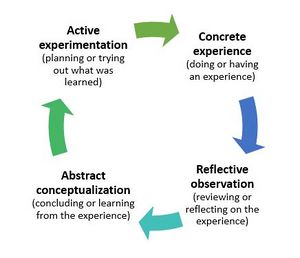Experiential Learning: Difference between revisions
Tanvivartak (talk | contribs) |
Tanvivartak (talk | contribs) |
||
| Line 8: | Line 8: | ||
David Kolb <ref> Kolb, D. (1984). Experiential learning: Experience as the source of learning and development. New Jersey7 Prentice Hall. </ref> proposed that experience was critical in developing knowledge construction, as learning occurs through discovery and active participation. Kolb defined learning as “the process whereby knowledge is created through the transformation of experience” (Kolb, 1984). | David Kolb <ref> Kolb, D. (1984). Experiential learning: Experience as the source of learning and development. New Jersey7 Prentice Hall. </ref> proposed that experience was critical in developing knowledge construction, as learning occurs through discovery and active participation. Kolb defined learning as “the process whereby knowledge is created through the transformation of experience” (Kolb, 1984). | ||
=== Stages of Learning === | |||
According to Kolb's experiential learning model, there are four stages central to experiential learning. | According to Kolb's experiential learning model, there are four stages central to experiential learning. | ||
| Line 17: | Line 19: | ||
# '''Abstract Conceptualization''' | # '''Abstract Conceptualization''' | ||
# '''Active Experimentation''' | # '''Active Experimentation''' | ||
=== Critique === | |||
One critique is that the model oversimplifies the learning process by assuming that it occurs linearly and sequentially while learning is often more complex and iterative in reality <ref> Fenwick, T. (2001). Experiential learning: A theoretical critique from five perspectives. Information Series No. 385. ERIC Clearinghouse on Adult, Career, and Vocational Education. https://files.eric.ed.gov/fulltext/ED464321.pdf </ref>. Additionally, the model may not adequately account for individual differences in learning styles and preferences and may not apply to all learning situations. | |||
Secondly, the model is too focused on cognitive processes and may neglect the role of affective and motivational factors in learning. For example, emotions, attitudes, and beliefs may significantly shape an individual's learning experience, but the model does not explicitly account for these factors. | |||
Lastly, the model is overly prescriptive and may not allow for the flexibility and creativity necessary for effective learning. By emphasizing a particular learning cycle, the model may not adequately account for the diverse approaches and strategies that individuals may use to learn and problem-solve. | |||
= Example = | = Example = | ||
Revision as of 13:54, 24 February 2023
Overview
Experiential learning builds on the work of Piaget, Lewin and Dewey [1]. It consists of several models that stress the importance of direct experience and reflective observation
Kolb's Experiential Learning Model
David Kolb [2] proposed that experience was critical in developing knowledge construction, as learning occurs through discovery and active participation. Kolb defined learning as “the process whereby knowledge is created through the transformation of experience” (Kolb, 1984).
Stages of Learning
According to Kolb's experiential learning model, there are four stages central to experiential learning.
- Concrete Experimentation - In this stage, each learner engages in an activity or task, which may be completely new or a reimagined experienced of the past. For learning to take place, the student must actively engage in the task
- Reflective Observation - - The learner in this stage steps back from the task to reflect on the task experience. This stage allows the learner to analyse the findings of the data and information collected while performing the task and reflecting on it.
- Abstract Conceptualization
- Active Experimentation
Critique
One critique is that the model oversimplifies the learning process by assuming that it occurs linearly and sequentially while learning is often more complex and iterative in reality [3]. Additionally, the model may not adequately account for individual differences in learning styles and preferences and may not apply to all learning situations.
Secondly, the model is too focused on cognitive processes and may neglect the role of affective and motivational factors in learning. For example, emotions, attitudes, and beliefs may significantly shape an individual's learning experience, but the model does not explicitly account for these factors.
Lastly, the model is overly prescriptive and may not allow for the flexibility and creativity necessary for effective learning. By emphasizing a particular learning cycle, the model may not adequately account for the diverse approaches and strategies that individuals may use to learn and problem-solve.
Example
Evidence
Implications and Design Critique
Conclusion
References
- ↑ Nielsen-Englyst, L. (2003). Game design for imaginative conceptualisation. Proceedings of the international workshop on experimantal interactive learning in industrial management, Allborg (pp. 149 – 164)
- ↑ Kolb, D. (1984). Experiential learning: Experience as the source of learning and development. New Jersey7 Prentice Hall.
- ↑ Fenwick, T. (2001). Experiential learning: A theoretical critique from five perspectives. Information Series No. 385. ERIC Clearinghouse on Adult, Career, and Vocational Education. https://files.eric.ed.gov/fulltext/ED464321.pdf

